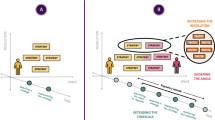Abstract
There is converging evidence from several psychological fields on the ways in which individuals engage in specific strategies to modify, alter, or accept their emotional experiences to obtain more desirable outcomes. The current Special Issue is dedicated to a series of examinations on how these self-regulatory strategies can promote resilience, create and sustain positive moods and intrinsic motivation, and aid in the repair of different negative emotions. The content of these articles are briefly reviewed in the context of additional ideas for scientific advancements in understanding and developing positive health.
Similar content being viewed by others
References
Bryant F.B. (1989). A four-factor model of perceived control: Avoiding, coping, obtaining, and savoring. Journal of Personality 57:773–797
Erber R., Erber M.W. (2000). The self-regulation of moods: Second thoughts on the importance of happiness in everyday life. Psychological Inquiry 11: 142–148
Folkman S., Moskowitz J.T. (2000). Positive affect and the other side of coping American Psychologist55:647–654
Forgas J.P. (1995). Mood and judgment: The affect infusion model (AIM). Psychological Bulletin 117: 39–66
Fredrickson B.L. (1998). What good are positive emotions? Review of General Psychology 2: 300–319
Hayes S.C., Follette V.M., Linehan M. (2004). Mindfulness, Acceptance, and Relationship:Expanding the Cognitive Behavioral Tradition. New York: Guilford Press
Keltner D., Bonanno G.A. (1997). A study of laughter and dissociation: Distinct correlates of laughter and smiling in bereavement. Journal of Personality and Social Psychology 73: 687–702
Langston C. A. (1994). Capitalizing on and coping with daily-life events: Expressive responses to positive events Journal of Personality and Social Psychology 67: 1112–1125
Larsen R.J. (2000). Toward a science of mood regulation Psychological Inquiry 11: 129–141
Mayer J. D., Salovey P. (1995). Emotional intelligence and the construction and regulation of feelings Applied and Preventive Psychology 4: 197–208
Rogers C.R. (1961). On Becoming a Person. New York: Avon
Sansone C., Smith J.L. (2000). Interest and self-regulation: The relation between having to and wanting to. In C. Sansone, J.M. Harackiewicz (Eds.), Intrinsic and Extrinsic Motivation: The Search for Optimal Motivation and Performance San Diego, CA: Academic Press. pp (341–372)
Wilson T.D., Centerbar D.B., Kermer D.A., Gilbert D.T. (2005). The pleasures of uncertainty: Prolonging positive moods in ways people do not anticipate Journal of Personality and Social Psychology 88: 5–21
Author information
Authors and Affiliations
Corresponding author
Rights and permissions
About this article
Cite this article
Kashdan, T.B. New developments in emotion regulation with an emphasis on the positive spectrum of human functioning. J Happiness Stud 8, 303–310 (2007). https://doi.org/10.1007/s10902-006-9013-6
Published:
Issue Date:
DOI: https://doi.org/10.1007/s10902-006-9013-6




